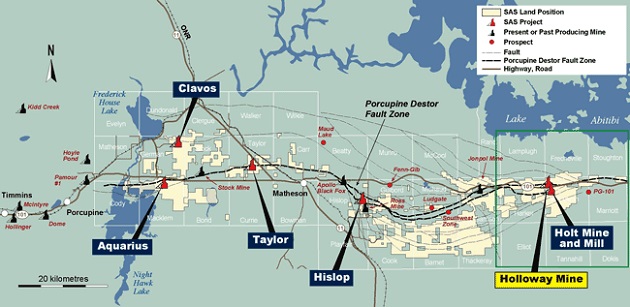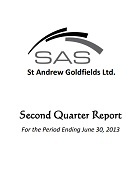Holloway Mine
Summary
The Holloway Mine is located at the eastern portion of St Andrew's land package in the Timmins Mining District. The Holloway Mine is situated on the north side of the Ontario Provincial Highway 101 East, with the Holt Mine and Mill located approximately 1.5 km away on the south side of the Highway.

History
Holloway-Harker History: Since the late 1930's Teddy Bear Valley Mines, Ltd. carried out an exploration program which included some underground development. Work lapsed until the mid 1980's. when Teddy Bear renewed exploration drilling on its claims and Noranda Exploration Company Limited (Noranda) began drilling on adjacent claims.
In 1988, drill holes from both properties intersected the upper portion of the deposit, now known as the Lightning Zone, which tops out at approximately 150 metres below surface. Noranda then formed a joint venture to earn an interest in the Teddy Bear property. In July 1991, Hemlo Gold Mines Inc. (Hemlo) acquired Noranda's interest in the Holloway project and surrounding claims. The Holloway Joint Venture was formed in 1992 to fund, develop, and operate the two properties as one mine.
Noranda put in a 441 metre exploration shaft in 1992 and the property moved into full production on October 1,1996. That same year Hemlo merged with Battle Mountain Gold Company (Battle Mountain). In January 2001, Newmont Canada Limited (Newmont) merged with Battle Mountain and the Holloway Mine was then operated by Newmont Canada Limited. In October of 2004, Newmont acquired the Holt-McDermott Mill and Mine assets from Barrick Gold Corporation (Barrick) and controlled 100% of the Holloway-Holt Project assets and land position. At year end 2005, the Holloway Mine had produced 0.91 million ounces of gold from 4.9 Mt of ore with a recovered average grade of 5.9 g/t Au.
In November 2006, SAS acquired from Newmont all of the shares of its wholly owned subsidiary Holloway Mining Company, which owned the Holloway-Holt gold mines. On January 1, 2007 St Andrew amalgamated with Holloway Mining Ltd. (formerly Holloway Mining Company) to retain 100% interest in the Holloway and Holt properties.
Geology and Mineralization
The defining structural characteristic of the property package and the most important feature is the Procupine-Destor Fault Zone ("PDFZ"), an east-west trending belt of deformed and interleaved clastic sedimentary rocks with several bands of mafic and ultramafic volcanic rocks, all of which are separated by multiple fault strands. There are at least two segments of age-dated Porcupine-type turbidites and one of Timiskaming conglomerate and sandstone within the deformation zone. The generally south facing nature of these sedimentary units splayed into the older Blake River assemblage to the south, and the intercalation of slivers of the older volcanic assemblages within the sedimentary units require the presence of dramatic fault displacements at or near contacts within the PDFZ to allow the structural imbrication of these lithologies (Rhys, 2005a).
The Lightning and Blacktop zone mineralization comprises replacement carbonate-quartzalbite- pyrite zones developed adjacent to and within the high strain zones that overprint earlier formed albite-hematite alteration that preferentially replaces variolitic flow units.
Holloway Deposit
The Holloway deposit is hosted by the 30 m to 150 m wide Holloway unit, a south dipping band of Fe-tholeiitic mafic volcanic rocks which is bounded to the north and south by south facing turbiditic sedimentary rocks and komatiitic ultramafic volcanic rocks, respectively. Mineralization occurs where a 200 m to 300 m wide corridor of east-northeast trending D2-D3 high strain zones obliquely crosses the Holloway unit, resulting in a deflection in its strike to east-northeast trends from east to west-northwest trends that are more typical at the property scale (Rhys, 2005a). Mineralization in the Holloway Mine comprises the Lightning, Middle, and Blacktop zones.
Mineral Reserves and Resources
Holloway Project - Mineral Reserves Estimate, December 31, 2011

Notes:
• Mineral Reserves are included within the Mineral Resources;
• Mineral Reserves were estimated by Management according to CIM definitions -- 2010;
• Mineral Reserves were estimated using an average long-term gold price of US$1,100 per ounce and an exchange rate of $1.00 = US$0.98; Mineral Reserves for Holloway were estimated using a cut-off grade of 3.5 g/t Au;
• Tonnes and gold ounce information is rounded to the nearest thousands and as a result, totals may not add exactly due to rounding.
Holloway Project -- Mineral Resource Estimate, December 31, 2011

Notes:
• Mineral Resources are inclusive of Mineral Reserves;
• Mineral Resources were estimated by Management according to CIM definitions -- 2010;
• Mineral Resources were estimated using an average long-term gold price of US$1,200 per ounce and an exchange rate of $1.00 = US$0.98;
• Mineral Resources were estimated using a cut-off grade of 3.0 g/t Au ;
• Mineral Resources for the Deep Thunder Zone, which is included in totals for the Holloway Mine, were estimated at a cut off grade of 2.5 g/t Au;
• Tonnes and gold ounce information is rounded to the nearest thousands and as a result, totals may not add exactly due to rounding.
Development and Mining
The Holloway Mine is accessed by a three-compartment, 5.5 metre diameter shaft to a depth of 867 metres. A second access shaft is available through the original 4.9 metre diameter exploration shaft to a depth of 441 metres. This shaft is used primarily as a ventilation raise and escape-way. Two internal ramps provide access to the mine workings. Holloway is a trackless mine with stopes mined using longhole mining methods with delayed backfill, or a variation of cut and fill mining methods. Fresh air is distributed to the mine using two internal ventilation raises connected to the shafts and the Blacktop Exhaust Raise.
SAS assumed operational control of the Holloway-Holt project on November 1, 2006. SAS produced a 43-101 compliant report for the Holloway-Holt project in the third quarter of 2008. The Company commenced pre-production work in May of 2009, and entered production in October 2009, ahead of schedule and under budget.
The mine is currently in production and ore is being shipped by truck to the Holt Mill for processing. The Holloway Mine is expected to produce between 20,000 - 23,000 ounces of gold for 2011.
Processing
Ore mined at the Holloway Mine will be processed at the Company's Holt Mill which is located 1km away, on the south side of Highway 101 East. Holloway ore has been processed at the Holt Mill since the commencement of Holloway Mine production in 1996.
Exploration
Given the exploration success in this region, and in particular, on the Holloway-Holt properties, this area is considered highly prospective for gold mineralization, particularly given the thick glacial overburden that can often mask the gold mineralization. The exploration potential on the Holloway project can be divided into two equally prospective areas, first, within and immediately adjacent to the gold mineralization previously discovered, namely the Lightval and Newmex property segments and at the Blacktop, Ghost, Pumphouse, and 42 E zones; and second, in new areas where conceptual exploration targets have been generated based on both past and recent theories that predict the controls on the location of gold mineralization.
Based on aeromagnetic patterns, and the locations of known alteration-high strain zones, examination of property geological and geophysical maps, in combination with known drill hole data, suggests that several east-northeast trending shear zones are developed across the area, including in the Lightval property area west of Holloway From the Lightval property eastward, beyond the Blacktop and Pumphouse Zones, there is unexplored gold potential in the footwall volcanic package, to the north of the correlative Lightning Zone volcanic package.
In addition, there remains excellent potential to add to the current mineral resource base immediately adjacent to the Holloway deposits that can be accessed from the present underground workings. This includes, but is not limited, to the following areas:
• Up and down plunge of the Holloway -- Lightning and Blacktop zones;
• The area to the east of Backtop;
• The Deeep Thunder Zone (which lies approximately 1km to the east of the Blacktop Zone; and
• The Smoke Deep Zone (which lies halfway between the Lightning and Blacktop zones.
Source: http://www.sasgoldmines.com/s/Holloway.asp

|